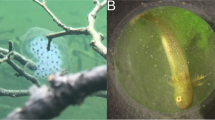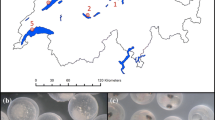Abstract
Tests of hypotheses of vertical transmission and competitive exclusion for particular resource-exchange mutualisms require assessments of the number and identity of partners. Unicellular green algae form a symbiosis with embryos of the northeastern yellow spotted salamander Ambystoma maculatum. The extent to which the composition of egg mass-associated taxa depends on temporal or spatial factors is unknown and the discovery of an endosymbiotic component to this symbiosis has increased the importance of knowing the specificity of the association. We assessed the diversity and relative abundance of algal and other unicellular eukaryotes in egg masses by subjecting DNA harvested from cells in egg capsules or water from breeding habitat to 18S amplicon sequencing. A nested sampling regime for two breeding seasons allowed comparisons among capsules within egg masses, among egg masses in ponds, between breeding locales, between pond water and capsule fluid, and between years. Based upon 4.33 X106 reads, we found no evidence inside fifty-eight egg capsules of algal lineages outside the Oophila clade and report that, whereas non-algal eukaryotic sequence diversity was low, cercozoan protists and chytridomycete fungi were sometimes abundant. There were weak or inconsistent egg mass, year or locale effects, but there was a very strong localization effect, indicating that capsules are rarefied spaces for eukaryotic aquatic taxa. This work provides a foundation for comparing microbial community structure within and among egg masses across the geographic range of the host.






Similar content being viewed by others
References
Andam, CP, Doroghazi JR, Campbell AN, Kelly PJ, Choudoir MJ, Buckley DH (2016) A latitudinal diversity gradient in terrestrial bacteria of the genus Streptomyces. mBio 7: e02200–15
Anderson MJ (2001) A new method for non-parametric multivariate analysis of variance. Austr Ecol 26:32–46
Bachmann MD, Carlton RG, Burkholder JM, Wetzel RG (1986) Symbiosis between salamander eggs and green algae: microelectrode measurements inside eggs demonstrate effect of photosynthesis on oxygen concentration. Canadian Journal of Zoology 64 (7):1586–1588
Bishop CD, Miller AG (2014) Dynamics of the growth, life history transformation and photosynthetic capacity of Oophila amblystomatis (Chlorophyceae), a green algal symbiont associated with embryos of the northeastern yellow spotted salamander Ambystoma maculatum (Amphibia) Symbiosis 63:47-57
Comeau, AM Douglas GM, Langille MI (2017) Microbiome Helper: a custom and streamlined workflow for microbiome research. mSystems 2: e00127–16
Denitstkiy A (2017) A symbiosis of amphibian embryos and larvae with unicellular green algae. Russ J Herp 24:223–227
Dhariwal A, Chong J, Habib S, King I, Agellon LB, Xia J (2017) MicrobiomeAnalyst: a web-based tool for comprehensive statistical, visual and meta-analysis of microbiome data. Nucl Acids Res 45:W180–W188
Ettl H, Gärtner G (1995) Syllabus der Boden-, Luft- und Flechtenalgen. pp i-vii, 1-721 Stuttgart: Gustav Fischer
Faith DP (1992) Conservation evaluation and phylogenetic diversity. Biol Conserv 61:1–10
Frank SA (1996) Host-symbiont conflict over the mixing of symbiotic lineages. Proc Roy Soc London B 263:339–344
Gatz AJ (1973) Algal entry into the eggs of Ambystoma maculatum. J Herp 7:137–138
Gilbert PW (1942) Observations on the eggs of Ambystoma maculatum with especial reference to the green algae found within the egg envelopes. Ecology 23:215–227
Gilbert PW (1944) The alga-egg relationship in Ambystoma maculatum, a case of symbiosis. Ecology 25:366–369
Goff LJ, Stein JR (1978) Ammonia: basis for algal symbiosis in salamander egg masses. Life Sci 22:1463–1468
Graham ER, Fay SA, Davey A, Sanders RW (2013) Intracapsular algae provide fixed carbon to developing embryos of the salamander Ambystoma maculatum. J Exp Biol 216:452–459
Hammen CS, Hutchison VH (1962) Carbon dioxide assimilation in the symbiosis of the salamander Ambystoma maculatum and the alga Oophila amblystomatis. Life Sci 1:527–532
Harrison R (1969) Stages and description of normal development of the spotted salamander, Ambystoma punctatum (Linn) pages 44–66 in S Wilens, editor organization and development of the embryo. Yale Univ Press, New Haven, Connecticut, USA
Hess S, Melkonian M (2013) The mystery of clade X: Orciraptor gen nov and Viridoraptor gen nov are highly specialized, algivorous amoebo-flagellates (Glissomonadida, Cercozoa). Protist 164:706–747
Hillebrand H (2004) On the generality of the latitudinal diversity gradient. Am Nat 2:192–211
Ichimura T (1971) Sexual cell division and conjugation-papilla formation in sexual reproduction of Closterium strigosum in: Proceedings of the Seventh International Seaweed Symposium University of Tokyo press, Tokyo, p 208-214
Ibelings BW, De Bruin A, Kagami M, Rijkeboer M, Brehm M, van Donk E (2004) Host parasite interactions between freshwater phytoplankton and chytrid fungi (Chytridiomycota). J Phyc 40:437–453
IUCN SSC Amphibian Specialist Group (2015) Ambystoma maculatum. The IUCN Red List of Threatened Species 2015: e.T59064A56540295. https://dx.doi.org/10.2305/IUCN.UK.2015-4.RLTS.T59064A56540295.en
Johnson CA, Bronstein JL (2019) Coexistence and competitive exclusion in mutualism. Ecology 100(1–8):e020708
Kanagawa T (2003) Bias and artifacts in multi-template polymerase chain reactions (PCR) J Biosc bioen 96:317-323
Kerney R, Kim E, Hangarter RP, Heiss AA, Bishop CD, Hall BK (2011) Intracellular invasion of green algae in a salamander host. Proc Natl Acad Sci U S A 108:6497–6502
Kerney R (2011) Symbioses between salamander embryos and green algae. Symbiosis 54:107–117
Kim E, Lin Y, Kerney R, Blumenberg L, Bishop C (2014) Phylogenetic analysis of algal symbionts associated with four North American amphibian egg masses. PLoS One 9:e108915
Kueneman JG, Parfrey LW, Woodhams DC, Archer HM, Knight R, McKenzie VJ (2014) The amphibian skin-associated microbiome across species, space and life history stages. Mol Ecol 23:1238–1250
Kumar S, Stecher G, Li M, Knyaz C, Tamura K (2018) MEGA X: molecular evolutionary genetics analysis across computing platforms. Mol Biol Evol 35:1547–1549
Lozupone C, Hamady AM, Kelley ST, Knight R (2007) Quantitative and qualitative beta-diversity measures lead to different insights into factors that structure microbial communities. Appl Env Microbiol 73:1576–1585
Statistics Kingdom 2017 Mann Whitney U test calculator [Internet]. [cited June, 2020]. Available from: http://www.statskingdom.com/170median_mann_whitney.html
Medlin L, Elwood HJ, Stickel S, Sogin ML (1988) The characterization of enzymatically amplified eukaryotic 16S-like rRNA-coding regions. Gene 71:491–499
Muto K, Nishikawa K, Kamikawa R, Miyashita H (2017) Symbiotic green algae in eggs of Hynobius nigrescens, an amphibian endemic to Japan. Phycol Res 65:171–174
Nema M, Hanson ML, Müller KM (2019) Phylogeny of the egg-loving green alga Oophila amblystomatis (Chlamydomonadales) and its response to the herbicides atrazine and 2,4-D. Symbiosis 77:23–29
Nemergut DR, Schmidt SK, Fukami T, O’Neill SP, Bilinski TM, Stanish LF, Knelman JE, Darcy JL, Lynch RC, Wickey P, Ferrenberg S (2013) Patterns and processes of microbial community assembly. Microbiol Mol Biol Rev 77:342–356
Orr H (1888) Note on the development of amphibians, chiefly concerning the central nervous system; with additional observations on the hypophysis, mouth, and the appendages and skeleton of the head. Quart J Micro Sci New Ser 29:295–324
Parks DH, Tyson GW, Hugenholtz P, Beiko RG (2014) STAMP: statistical analysis of taxonomic and functional profiles. Bioinformatics 30:3123–3124
Pinder A, Friet S (1994) Oxygen transport in egg masses of the amphibians Rana sylvatica and Ambystoma maculatum: convection, diffusion and oxygen production by algae. J Exp Biol 197:17–30
Polz M, Cavanaugh C (1998) Bias in template-to-product ratios in multi-template PCR. Appl Env Microbiol 64:3724–3730
Powell MJ (1994) Production and modifications of extracellular structures during development of chytridiomycetes. Protoplasma 181(1–4):123–141
R Core Team (2019). R: a language and environment for statistical computing. R Foundation for Statistical Computing, Vienna, Austria https://www.R-project.org/
Rebollar EA, and Harris RN (2019) Editorial: ecology of amphibian-microbial symbioses. Front Microbiol 10:766 doi: 103389/fmicb201900766
Singh G, Dal Grande F, Divakar PK, Otte J, Crespo A, Schmitt I (2017) Fungal-algal association patterns in lichen symbiosis linked to macroclimate. New Phytol 214:317–329
Schultz N (2016) The symbiotic green algae, Oophila (Chlamydomonadales, Chlorophyceae): a heterotrophic growth study and taxonomic history. Master’s Thesis University of Connecticut
Tattersall GJ, Spiegelaar N (2008) Embryonic motility and hatching success of Ambystoma maculatum are influenced by a symbiotic alga. Canadian Journal of Zoology 86(11):1289–1298
Tedersoo L, Nara K (2010) General latitudinal gradient of biodiversity is reversed in ectomycorrhizal fungi. New Phytol 185:351–354
Valls JH, Mills NE (2007) Intermittent hypoxia in eggs of Ambystoma maculatum: embryonic development and egg capsule conductance. Journal of Experimental Biology 210(14):2430–2435
Watanabe M, Kawachi M, Hiroki M, Kasai F (2000) NIES Collection list of strains, Sixth Edition Microalgae and Protozoa microbial culture collections, National Institute for Environmental Studies, Tsukuba, Japan 159 pp
Wickham H (2016). ggplot2: elegant graphics for data analysis. Springer-Verlag New York. ISBN 978-3-319-24277-4
Wickham et al (2019) Welcome to the tidyverse. J Open Source Software 4:1686. https://doi.org/10.21105/joss.01686
Wille N (1909) VII Abteilung Chlorophyceae Syllabus der Pflanzenfamilien Band 6 (Engler, A Eds) Berlin: Verlag von Gebrüder Borntraeger
Zamudio KR, Wieczorek AM (2007) Fine-scale spatial genetic structure and dispersal among spotted salamander (Ambystoma maculatum) breeding populations. Mol Ecol 16:257–274
Zeng Q, Sukumaran J, Wu S, Rodrigo A (2015) Neutral models of microbiome evolution. PLoS Comp Biol 11:e1004364. https://doi.org/10.1371/journalpcbi1004365
Acknowledgements
This work began during a sabbatical to CDB, which was gratefully held in John Archibald’s laboratory (Dalhousie University) and was supported by a Discovery Grant to CDB from the Natural Sciences and Engineering Research Council of Canada. EJ conducted DNA extractions and PCR, prepared some graphs and was supported by a Undergraduate Student Research Assistantship from the Natural Sciences and Engineering Research Council of Canada; LG first developed methods to extract IF from egg capsules and then did so for all samples; CDB collected egg masses, conducted DNA extractions and PCR, performed data analyses and wrote the manuscript. All authors reviewed and revised the manuscript. The authors declare no conflicts.
Author information
Authors and Affiliations
Corresponding author
Additional information
Publisher’s note
Springer Nature remains neutral with regard to jurisdictional claims in published maps and institutional affiliations.
Electronic supplementary material
Online Resource 1
18S Eukarya standard operating procedure, v1 (PDF 88 kb)
Online Resource 2
Sequencing statistics as a function of treatment of samples prior to sequencing (raw vs. PCR) for 2016 (a) and 2017 (b) (PDF 25 kb)
Online Resource 3
A table of F-statistics describing differences among groups (a) and a binning scheme to describe the relative magnitude of effect (b) (PDF 43 kb)
Online Resource 4
Efficacy of detection of non-Oophila algal cells. Known quantities of cells of C. vacuolatum were injected into, then harvested from, A. maculatum egg capsules. Harvested cells were then subjected to amplicon sequencing and recovery was expressed as the percentage of sequences detected, relative to the quantity of cells injected. (PDF 82 kb)
Rights and permissions
About this article
Cite this article
Jurga, E., Graham, L. & Bishop, C. Oophila is monophyletic within a three-taxon eukaryotic microbiome in egg masses of the salamander Ambystoma maculatum. Symbiosis 81, 187–199 (2020). https://doi.org/10.1007/s13199-020-00693-w
Received:
Accepted:
Published:
Issue Date:
DOI: https://doi.org/10.1007/s13199-020-00693-w




